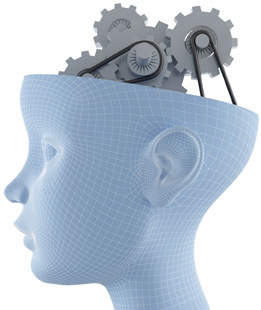Module 2
1. Module 2
Module 2 Introduction
Have you ever played a game with another person and were just blown away by this person’s ability to strategize and win games? How does he or she know what your next move is going to be before you even make it? How can patterns be identified and how does the opponent “see” the puzzle go together so easily?

Hemera/Thinkstock
The ability to reason is a valuable skill. Reasoning allows you to analyze patterns in games, puzzles, and other problems, and it enables you to come up with winning strategies and solutions. Reasoning is used to generate theories that can be used to generalize situations or predict outcomes. These theories can then be used to solve specific problems.
Reasoning is used every day by people in a wide variety of situations. For instance, in this module you will investigate how reasoning is used to develop and adapt strategies for playing games. You will also examine how designers, architects, and engineers use reasoning to visualize, create, analyze, and verify their designs.
In this module you will investigate the following inquiry questions:
- How can reasoning be used to develop and analyze problem-solving strategies?
- How can reasoning be used to verify aspects of a design?
To investigate these module questions, you will focus on the following lessons and corresponding inquiry questions shown in the table below.
|
Lesson |
Title |
Lesson Inquiry Questions |
|
1 |
Strategy in Games, Puzzles, and Patterns |
How can different personal strategies be used to solve a puzzle or win a game? |
|
2 |
Conjectures and Inductive Reasoning |
How can reasoning be used to make predictions or generalizations? |
|
How can a prediction be invalidated? |
||
|
3 |
Proving Conjectures |
How can logical reasoning be used to prove conjectures made about games and puzzles? |
|
4 |
Identifying Errors in Proofs |
How can the validity of a proof be justified? |
|
5 |
Reasoning to Solve Problems, Puzzles, and Games |
How can inductive and deductive reasoning be used in problem solving? |
|
How can inductive and deductive reasoning be used to determine a strategy to solve a puzzle or win a game? |
||
|
6 |
Exploring Parallel Lines |
What relationships can be identified between pairs of angles formed by transversals and parallel lines in various designs? |
|
How can inductive reasoning be used to make conjectures about the relationships of angles formed when a line intersects a pair of parallel lines? |
||
|
7 |
Proving Conjectures About Angles Formed by Parallel Lines |
How can you prove the properties of angles formed by parallel lines and a transversal? |
|
8 |
Using the Properties of Angles Formed by Parallel Lines to Solve Problems |
How can different strategies be applied to construct parallel lines? |
|
How can the properties of angles formed by parallel lines and a transversal be used to solve problems? |
||
|
9 |
Proving Angle Properties in Triangles |
How can properties of angles in triangles be proven using deductive reasoning? |
|
How can the properties of angles in triangles be used to solve problems? |
||
|
10 |
Congruent Triangles |
What is the minimum amount of information needed to create two triangles that are congruent? |
|
How can deductive reasoning be used to prove that triangles are congruent? |
||
|
11 |
Reasoning to Solve Design and Layout Problems |
What relationships can be identified between angles and sides in polygons? |
|
How can the properties of angles and polygons be used to solve design and layout problems? |
Module 2 Project
At the end of this module, you will apply your reasoning skills to develop and analyze a design for an object of your choice. You may also choose to analyze an existing design in nature, architecture, art, games, or another area of interest to you. For specific instructions, refer to the Module 2 Project.
Strategies for Success
You may find the following strategies useful to support your success in this module.
Strategy 1: Course Glossary
Recall from the course introduction that you will be building your own version of a glossary in Mathematics 20-2. As you encounter new terms in the lesson, you can add them to your Glossary Terms document. You should have started a Glossary Terms document in Module 1 and saved it to your course folder. If not, save the Glossary Terms document now to your course folder.
Strategy 2: Notes Organizer
A notes organizer is a tool for recording key concepts, terms, formulas, examples, or tips from each lesson in one place to refer to as you work through the course. Notes can be organized in a variety of formats. If you have not done so already, take a look at the Notes Organizer document for some ideas.

Hemera/Thinkstock
Strategy 3: Supplementary Resources
You will be referring to Chapter 1 (pages 4 to 65) and Chapter 2 (pages 67 to 125) of the Principles of Mathematics 11 textbook for Module 2. Take time to flip through these textbook pages. Look at illustrations, margin features, and main titles to get a sense of the concepts you will be covering in this module.
There are also resources available on LearnAlberta.ca. Your teacher can provide you with a username and a password to access content on LearnAlberta. An Internet search can also provide you with useful information. Just remember to consider the source of the information.
Are you ready to begin Module 2: Logic and Geometry? It all starts with Lesson 1 where you play and then compare different personal strategies for winning a game or solving a puzzle.